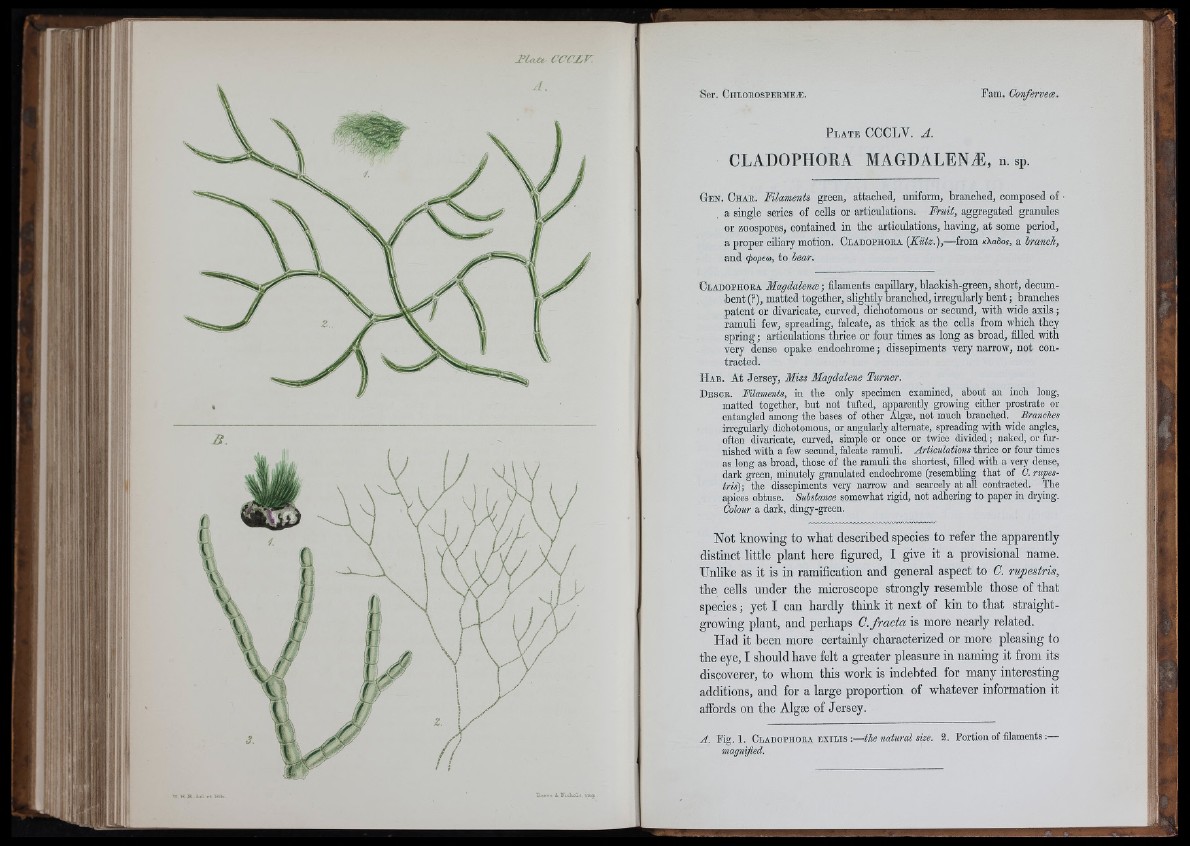
i; ]'•
i ''i
!
w. H i l . i.'- »1 MtX ■Rmv« i NioW.A
P l a t e CCCLV. A.
CLADOPHORA MAGDALLNÆ, n. sp.
G e n . C h a r . MlamenU g r e en , a tta ch ed , u n ifo rm , b ran ch ed , com p o sed o f -
a s in g le series o f c e lls or a r ticu la tio n s. F m it, a g g r e g a ted g ran u les
or zo o sp o r e s, co n ta in ed in th e a r ticu la tio n s, h a v in g , a t som e period,
a proper ciliary m o tio n . C la d o p h o r a [Kiitz.],— from ¡¿Kabos, a branch,
an d (j>op€<o, to bear.
C la d o p h o r a Magdalena ; filam en ts capillary, b la o k ish -g r e en , sho r t, d e cum b
e n t (?), m a tted to g e th e r , s lig h t ly b ran ch ed , ir regu la r ly b en t ; b ranches
p a ten t or d iv a rica te, cu rv ed, d ich o tom o u s or s e cu n d , w ith w id e a x ils ;
r am u li few , spr ead in g , fa lc a te , as th ick a s th e c e lls from w h ich th ey
sp r in g ; a r ticu la tion s th r ic e or four tim e s as lo n g as broad, filled w ith
v e r y d en se op ak e en d o ch rom e ; d issep im en ts v e r y n arrow, n o t c o n tra
c ted.
H a b . A t J e r se y , Miss Magdalene Turner.
Desce. Filaments, in the only specimen examined, about an inch long,
matted together, but not tufted, apparently growing either prostrate or
entangled among the bases of other Algæ, not much branched. Branches
in-egularly dichotomous, or angularly alternate, spreading -with wide angles,
often divaricate, curved, simple or once or twice divided ; naked, or furnished
with a few secund, falcate ramuli. Articulations thrice or fom- times
as long as broad, those of the ramuli. the shortest, fiUed with a very dense,
dark green, minutely granulated endochrome (i-esembling that of C. rwpes-
tris); the dissepiments very narrow and scarcely at all contracted. The
apices obtuse. Substance somewhat rigid, not adhering to paper in drying.
Colour a dark, dingy-green.
Not knowing to what described species to refer the apparently
distinct little plant here figured, I give it a provisional name.
Unlike as it is in ramification and general aspect to C. rupestris,
the cells under the microscope strongly resemble those of that
species ; yet I can hardly think it next of kin to that straight-
growing plant, and perhaps C. fracta is more nearly related.
Had it been more certainly characterized or more pleasing to
the eye, I should have felt a greater pleasure in naming it from its
discoverer, to whom this work is indebted for many interesting
additions, and for a large proportion of whatever information it
affords on the Algæ of Jersey.
A. Fig. 1. Cladophora EXiLis :—the natural size. 2. Portion of filaments ;—
il
I «1
m
S i
s
I-l